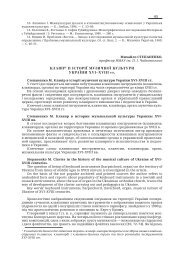Академия искусств Украины ИНСТИТУТ ПРОБЛЕМ ...
Академия искусств Украины ИНСТИТУТ ПРОБЛЕМ ...
Академия искусств Украины ИНСТИТУТ ПРОБЛЕМ ...
You also want an ePaper? Increase the reach of your titles
YUMPU automatically turns print PDFs into web optimized ePapers that Google loves.
МИРОВОЗЗРЕНЧЕСКИЕ УНИВЕРСАЛИИ<br />
8<br />
effort to propose radically new conception, her own view on the crisis phenomenon in art,<br />
on the methods of creation of a new artistic canvas of the culture. Yulia Romanenkova puts<br />
an accent on the underestimated role of the transition periods of the world art, justifying<br />
them for a viewer as a consumer of the art product. The author makes acute the problem<br />
of the unity of the finalizing periods in the history of art, putting at the background worldview<br />
universalities; viewing many classical works of art from another angle and through<br />
quite another prism. The author proposes to introduce the new terminology into the art<br />
studies, which has no analogy either in the Russian or in the Ukrainian language, and which<br />
has never been widely used before. One of the terms is Stilwandel or Stilwandlung and it is<br />
used in the title of the monograph. This term means transformations happening within<br />
artistic style at the period of its fading. This concept stands also for signs of the birth of a<br />
new style birth. «Mannerist constant», «mannerist dominant» of the creative process, «laoconian<br />
work of art» are another new introductions of the author.<br />
The monograph investigates the categories that earlier were designated by philosophers,<br />
culture and art researchers mainly by academic and traditional methods. Yulia<br />
Romanenkova undertakes a risky attempt to put crisis periods of the art history as its milestones<br />
and not as «Golden ages» as it was done previously. The periods of crisis become the<br />
main points, which were subjected to rethinking in the monograph.<br />
For the first time the crisis in art was closely looked upon in the post Renaissance period<br />
when the Renaissance was followed by the Mannerism. Judging on the nature, character,<br />
philosophical and aesthetical foundations of the Mannerism, the researcher insists upon<br />
its non temporal character. Such a condition of art, style, creative personality repeats each<br />
time when the pick of creation process, flourishing of the epoch come to an end. The idea<br />
of the transitional character of every historical epoch was articulated previously by many<br />
scientists, but in the book this idea has been transformed and proved by examples, gathered<br />
from various epochs and styles. The stages of the so-called degradation of art were analyzed<br />
from the opposite viewpoint. The features, previously characterized as degradation and<br />
signs of fading are regarded now as forerunners of a new kind of art and a future outburst<br />
of the creative activity. The author proposes a new scale of evaluation of the period of art<br />
stagnation. The idea of the universal character of mannerist features, their presence in any<br />
period dictates the necessity of their unbiased reevaluation. The researcher finds out «her<br />
own Mannerism» and presents proofs, based on the artistic material of various epochs. The<br />
actuality of conception grows visibly in the contemporary process of culture creation.<br />
It is difficult to come to terms with a thought that Mannerism was much more important<br />
and interesting for the history of art then the Hellenism and the Renaissance. Well<br />
known and widespread scale of art values is being transformed; a lot of positions are changing<br />
its places. The author claims that fixed grandiosity of Phidias and Polycletos was less<br />
alive then disharmony, asymmetry and turbulence of Skopas. The latter made more influence<br />
contribution into the understanding of the art process. The main component of art<br />
should not be searched at the heights of Michelangelo or old Titian. Such theory does not<br />
mean overthrowing art idols or a revolt against geniuses and sing anthems and praise «second<br />
role» personalities in art as main goal. The research does not try to win a victory over<br />
ПЕРИОДОВ STILWANDLUNG<br />
titans. There is no effort in the book to change the places of the first and secondary ones.<br />
The notion of the pedestal art is formulated in one of the chapters of the book. The notion<br />
means the creations of the «second role» personalities. The tragedy and the anxiety of the<br />
second role personality give valuable and fruitful material for the art research. Critical self<br />
esteem, search of the individual style, following the great examples leads to the emergence<br />
of a new style, original methods, and means of the artistic expressions. But the main point<br />
is a search for something new, and this process is most important. The intricate process of<br />
search became the principal object of the author’s investigation. The proofs of the presence<br />
of the mannerist universalities in the contemporary art are convincing. The material is not<br />
historically stable yet; it supposes certain difficulties when dealing with it. The author states<br />
that the threshold between 20th and 21st centuries is one of the vivid examples of<br />
Stilwandlung, and its universalities are easier to detect on the canvas of the contemporary<br />
culture, then in the previous periods. The works of many artists are subjected to deep and<br />
strict analyses, aiming to find out novelty and originality of artists’ individual manner.<br />
Analogous lines are drawn to the works of arts of earlier periods, dismantling the claims of<br />
some contemporary artists to innovations. The book posts the problem of the dilettantism<br />
and professionalism.<br />
The monograph by Yulia Romanenkova should not be considered as a rewritten «Art<br />
Bible», and the author does not present herself as «a messiah» of the theory of art and artistic<br />
critique.<br />
The theory of «the repeated Mannerism» describes its constant «reincarnations»,<br />
doubts significance of the pick periods in art history and justifies the periods of «fading»<br />
and downfall. The book prompts to review traditional outlook on the art phenomena. Even<br />
if the reader come to the quite opposite conclusion after reading the monograph, main goal<br />
of this work is reached. The monograph strives to overcome one-sided narrow analyses. The<br />
author’s conception is challenging and opens a new perspective on the analyses of the crisis<br />
periods in art and their role in the future emergence of the new artistic phenomena.<br />
Undoubtedly, this book should stir hot discussions among art researchers, historians and<br />
art critics.<br />
Victor SYDORENKO,<br />
Academician, Director of the Modern Art Research Institute<br />
of the Academy of Arts of Ukraine

















